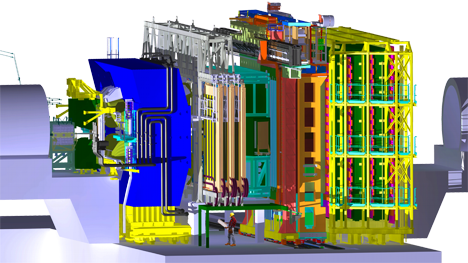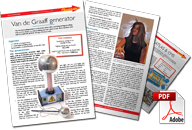LHCb
 The layout of the LHCb detector, with a picture of a construction worker for scale. LHCb looks quite different to the other experiments in the LHC, in that it’s not cylindrical. That’s because the B-mesons which it’s looking for tend not to fly out in all directions, but instead fly at small angles to the direction of the beam.
The layout of the LHCb detector, with a picture of a construction worker for scale. LHCb looks quite different to the other experiments in the LHC, in that it’s not cylindrical. That’s because the B-mesons which it’s looking for tend not to fly out in all directions, but instead fly at small angles to the direction of the beam.
LHCb is looking specifically for certain types of particle decays involving B-mesons: particles containing a beauty quark. These reactions will allow us to very precisely differentiate matter and antimatter—but why does that, er, matter?
All particles have an antimatter twin with the opposite electrical charge. For example, the negatively-charged electron’s antiparticle is called a positron, for obvious reasons. As the Universe cooled from being a searing ball of pure energy in the moments after the Big Bang, it’s thought that an equal amount of matter and antimatter should have been created.
Matter and antimatter are not happy bedfellows: when one comes into contact with the other, they annihilate in a flash of gamma radiation. Consequently, it’s pretty obvious that there isn’t a lot of antimatter here on Earth, otherwise life would be rather more hazardous than it is, with things forever disappearing in huge flashes of energy!
In fact, it seems that the observable Universe is pretty much entirely matter (there are no huge regions of annihilating matter and antimatter between the stars) which begs the question: where has all the antimatter gone?
LHCb
LHC beauty
length:
20 m
mass:
4500 tonnes
angle covered:
17° × 14°
LHCb is looking for tiny differences in the way that matter and antimatter react, in an attempt to understand this mystery. Perhaps a little bit less antimatter was created in the first place, or perhaps it behaved a bit differently in subsequent reactions meaning that, when all the annihilating was over just after the birth of the Universe, a small excess of matter was left over which, ultimately, went on to form us.
It’s looking at these tiny differences primarily using particles called B-mesons, which contain a beauty quark. Also known, less romantically, as a bottom quark, these are the second heaviest kind of quark known, a thousand times heavier than the up and down quarks which make up protons and neutrons.



